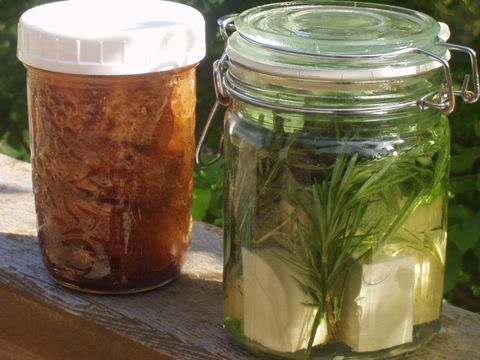Bryanna Clark Grogan’s Vegan Feast Kitchen/ 21st Century Table: The kitchen journal of a vegan food writer.. I'm on Facebook and Twitter (see links in sidebar at right).
Saturday, November 13, 2010
ZA'ATAR, AN ANCIENT HERB, A FRAGRANT, TANGY SPICE MIX FROM THE MIDDLE EAST


(Still working on the photos for the book-- next week I'll have more freedom to blog!)

Homemade Pita Bread Triangles with Olive oil and Za'atar (“manakeesh” in Arabic; and I've seen it also referred to as "manoosh")
The bread above was served as part of a summer dinner with hummus and eggplant dip, but it is a common breakfast item in the Middle East and the Levant. In that region, it is commonly believed that za'atar, a mixture of wild thyme, lemony ground sumac and sesame seeds (and sometimes salt), strengthens and clears the mind-- for this reason school children in the region are urged ot eat a slice of manakeesh before leaving home to take exams! (Here's my recipe for wholewheat pita and manakeesh.) And who knows? Herbs are now being found to contain powerful antioxidants, so it may have some science behind it! (Thyme oil contains anti-inflammatory and antiseptic qualities.) It can't hurt, anyway, and anything that may clarify my mind is a good thing! Of course, if it tastes good, too, all the better!
If you've never tasted za'atar (also spelled za'tar, zatar, zatr, zahatar, satar), prepare to be hooked! The taste of a za'atar mixture can described be tangy, herbal, nutty, or toasty-- actually all of the above!(The word can be used for wild thyme, or for the mixture of thyme, sumac, sesame and salt, by the way.) You can either spread it on flatbreads or pita with olive oil, or dip the bread in a mixture of olive oil and za'atar. (Use a really good extra virgin olive oil that you enjoy uncooked.) I sprinkle it on top of some soups (try it on Palestinian Red Lentil Soup , Levantine Bean Soup , Silky Sweet Potato and Red Lentil Soup or Balkh Brown Lentil Soup), on tofu feta and on dips and other vegan cheese preparations. It would be great on grilled or fried tofu, or rubbed into your favorite seitan. Try it in salad dressings and on latkes (potato pancakes) or oven-fried potatoes, sweet potatoes, cauliflower, couscous, grilled zucchini, cucumber salad, tomatoes-- I'm sure you'll come up with many other ways to use it!
UPDATE, June 1, 2012: This is a GREAT article on za'atar!!)
According to many who grew up eating za'atar every day, the flavor of our domestic thyme pales in comparison to the flavor of wild thyme picked in the spring by mothers and grandmothers and dried for the year at home. But it gets confusing-- I've seen wild thyme equated with wild marjoram or hyssop, too. In any case, I'm sure that the wild herb does have a stronger flavor than our domestic type. In our part of the world, experiment with combinations of our domestic thyme, marjoram and/or oregano. You may be able to find wild thyme, perhaps from Greece or Lebanon, in Middle Eastern or Greek grocery stores.
You can buy za'atar, of course, in Middle Eastern stores (online, too). But it's fun to come up with your own recipe (see below). My absolute favorite za'atar is Zatoun fair trade brand, available from Ten Thousand Villages fair trade markets in Canada (you can order online) and here in the USA. The aroma of the wild thyme in this product is soooooo amazing-- it bears no resemblance to the dried thyme we usually have available to use.
A SIMPLE ZA'ATAR FORMULA TO START WITH:
Of course everyone's mother or grandmother has the perfect formula, so go online and search for za'atar recipes (see all the different spellings above), or check out Middle Eastern and Levantine cookbooks for recipes. (Here is one.) I've seen recipes that also add caraway seed and/or a little allspice. In the book "Classic Vegetarian Cooking from the Middle East and North Africa
For a small amount, mix 4 tablespoons dried thyme (or a combination of herbs as mentioned above) with 2 tablespoons ground sumac
ABOUT SUMAC: This ingredient is ground from a berry from the Mediterranean Sumac tree. Sumac is deliciously tangy and sour with hints of lemon. Because of its flavor it is used as a souring agent instead of, or in addition to, citrus juice or vinegar. (It is a main ingredient in the delicious Lebanese salad, Fattoush. Read more about it here and here.
My Tofu Feta -- one jar with za' atar and oil.

Happy Experimenting with Za'atar!

Subscribe to:
Post Comments (Atom)
7 comments:
I think the tofu feta looks great. I am intrigued about za'tar. The "mind clearing" aspect has me ready to try it.
Oh this is great! Especially for my vegan friend. I will definitely recommend this recipe to her. Thanks for sharing by the way! :)
I LOVE Za'atar. My family lived in the Middle East for several years when I was growing up and I fell in love with it then. I haven't had it for a long time, but reading this post really makes me crave it again. The flavor is sooo amazing, it is really hard to describe. It is a totally addicting tangy, nutty and herbally flavor. My favorite way to eat it is on hot fresh pita bread with olive oil and smothered in the seasoning. Yum.
What a coincidence, I wrote about za'taar last Friday!
I just recently learned the wonders of za'atar. I've found that it goes great with all cruciferous vegetables (especially Brussels sprouts!) and spinach. I made it with store-bought sumac and using oregano, marjoram and thyme that my grandma has grown herself.
Oh, I will have to try it on roasted cauliflower and Brussels sprouts! Thanks, Maija!
Great Post!!
If you want the olive oil in its purest form, Buy extra virgin Olive oil online from Zeedpantry at a great price.
Click Here: Order Extra Virgin Olive Oil
Post a Comment